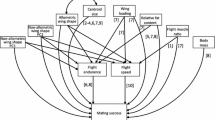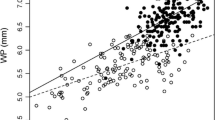Abstract
Alternative mating tactics (AMT) occur in several animal taxa as a way to respond to physiological or environmental factors that affect reproductive success. In other words, males can exhibit different mate acquisition tactics associated with phenotypic variations. Here we present the case of Epipleoneura williamsoni, a non-territorial Neotropical damselfly in which larger males actively search for females along the margins of streams and smaller males remain perched on the vegetation and adopt a sit-and-wait strategy. Males were captured, marked and behavioral observations were conducted to take notes on the spatial displacement of individuals. We then measured male body size and agility to test whether these traits could be used to predict flight ability and thus AMT’s. Agility was measured by the ȓ2(S) coefficient, which is a surrogate of flight ability and maneuverability. The results show that body size was positively correlated with male flight ability and agility. However, male agility did not predict the adopted AMT. These results suggest that the strategies adopted by E. williamsoni males may be a reflection of body condition. This study adds evidence on how selection may act on different phenotypes within a population and how body size variations may result in different displacement capacities and flight agility.

Similar content being viewed by others
References
Alcock J (1979) The evolution of intraspecific diversity in male reproductive strategies in some bees and wasps. In: Blum M (ed) Sexual selection and reproductive competition in insects. Academic press, Athens, pp 381–402
Arrese EL, Soulages JL (2010) Insect fat body: energy, metabolism, and regulation. Annu Rev Entomol 55:207
Balenger SL, Zuk M (2015) Roaming Romeos: male crickets evolving in silence show increased locomotor behaviours. Anim Behav 101:213–219
Bertram SM (2002) Temporally fluctuating selection of sex limited signaling traits in the Texas field cricket, Gryllus texensis. Evolution 56:1831–1839
Blanckenhorn WU, Preziosi RF, Fairbairn DJ (1995) Time and energy constraints and the evolution of sexual size dimorphism - to eat or to mate? Evol Ecol 9:369–381
Blanckenhorn WU (2005) Behavioral causes and consequences of sexual size dimorphism. Ethology 111:977–1016
Boyce MS, Perrins CM (1987) Optimizing great tit clutch size in a fluctuating environment. Ecology. https://doi.org/10.2307/1938814
Campanella PJ, Wolf LL (1974) Temporal leks as a mating system in a temperate zone dragonfly (Odonata: Anisoptera) I: Plathemis lydia (Drury). Behaviour 51:49–87
Contreras-Garduño J, Canales-Lazcano J, Córdoba-Aguilar A (2006) Wing pigmentation, immune ability, fat reserves and territorial status in males of the rubyspot damselfly, Hetaerina americana. J Ethol 24:165–173. https://doi.org/10.1007/s10164-005-0177-z
Corbet PS (1999) Dragonflies: behaviour and ecology of Odonata. Harley Books, Colchester
Cordero-Rivera A (1999) Forced copulations and female contact guarding at a high male density in a calopterygid damselfly. J Insect Behav 12:27–37
Cordero-Rivera A, Perez FE, Andres JA (2002) The effect of handling damage, mobility, body size and fluctuating asymmetry on lifetime mating success of Ischnura graellsi (Rambur) (Zygoptera: Coenagrionidae). Odonatologica 31:117–128
Córdoba-Aguilar A, Cordero-Rivera A (2005) Evolution and ecology of Calopterygidae (Zygoptera: Odonata): status of knowledge and research perspectives. Neotrop Entomol 34:861–879
Córdoba-Aguilar A (2008) Dragonflies and damselflies: model organisms for ecological and evolutionary research. Oxford University Press, Oxford
Córdoba-Aguilar A, Jiménez-Cortés JG, Lanz-Mendoza H (2009) Seasonal variation in ornament expression, body size, energetic reserves, immune response, and survival in males of a territorial insect. Ecol Entomol 34:228–239
Córdoba-Aguilar A, González-Tokman DM (2014) The behavioral and physiological ecology of adult rubyspot damselflies (Hetaerina, Calopterygidae, Odonata). Adv Study Behav 46:311–341
Córdoba-Aguilar A, Munguía-Steyer R (2015) Be or not to be? Mating success and survival trade-offs when switching between alternative reproductive tactics. J Evol Biol 28:2119–2124
Crompton B, Thomason JC, McLachlan A (2003) Mating in a viscous universe: the race is to the agile, not to the swift. Proc R Soc B Biol Sci 270:1991–1995
Cummings ME, Gelineau-Kattner R (2009) The energetic costs of alternative male reproductive strategies in Xiphophorus nigrensis. J Comp Physiol A 195:935–946
Danforth BN (1991) The morphology and behavior of dimorphic males in Perdita portalis (hymenoptera: Andrenidae). Behav Ecol Sociobiol 29:235–247
Ellington CP (1984) The aerodynamics of hovering insect flight. II. Morphological parameters. Philos Trans R Soc B 305:17–40
Emlen ST, Oring LW (1977) Ecology, sexual selection, and the evolution of mating systems. Science 197:215–223
Fincke OM (1982) Lifetime mating success in a natural population of the damselfly, Enallagma hageni (Walsh) (Odonata: Coenagrionidae). Behav Ecol Sociobiol 10:293–302
Fincke OM (1985) Alternative mate-finding tactics in a non-territorial damselfly (Odonata: Coenagrionidae). Anim Behav 33:1124–1137
Foley AM, DeYoung RW, Hewitt DG, Hellickson MW, Gee KL, Wester DB, Miller KV (2015) Purposeful wanderings: mate search strategies of male white-tailed deer. J Mammal 96:279–286
Ford RG, Krumme DW (1979) The analysis of space use patterns. J Theoret Biol 76:125–155
Forsyth A, Montgomerie RD (1987) Alternative reproductive tactics in the territorial damselfly Calopteryx maculata: sneaking by older males. Behav Ecol Sociobiol 21:73–81
Freeman S, Herron JC (2007) Variation among individuals. In: Freeman S, Herron JC (eds) Evolutionary analysis. Pearson Prentice Hall, Upper Saddle River, pp 147–178
Guillermo-Ferreira R, Del-Claro K (2011) Resource defense polygyny by Hetaerina rosea Selys (Odonata: Calopterygidae): influence of age and wing pigmentation. Neotrop Entomol. https://doi.org/10.1590/S1519-566X2011000100011
Guillermo-Ferreira R, Del-Claro K (2012) Territoriality and male-biased sexual size dimorphism in Argia reclusa (Odonata: Zygoptera). Acta Etholog 15:101–105
Hooper RE, Tsubaki Y, Siva-Jothy T (1999) Expression of a costly, plastic secondary sexual trait is correlated with age and condition in a damselfly with two male morphs. Physiol Entomol 24:364–369
Kelly CD, Neyer AA, Gress BE (2014) Sex-specific life history responses to nymphal diet quality and immune status in a field cricket. J Evol Biol 27:381–390
Kelly CD (2015) Male-biased sex ratios and plasticity in post-insemination behaviour in the New Zealand stick insect Micrarchus hystriculeus. Behaviour 152:653–666
Lease HM, Wolf BO (2011) Lipid content of terrestrial arthropods in relation to body size, phylogeny, ontogeny and sex. Physiol Entomol. https://doi.org/10.1111/j.1365-3032.2010.00767.x
Mills SC, Reynolds JD (2003) Operational sex ratio and alternative reproductive behaviours in the European bitterling, Rhodeus sericeus. Behav Ecol Sociobiol 54:98–104
National Institutes of Health (2005) ImageJ image processing and analysis in java. https://imagej.nih.gov/ij/index.html. Accessed 20 December 2017
Oliveira RF, Taborsky M, Brockmann HJ (2008) Alternative reproductive tactics an integrated approach. Cambridge University Press, Cambridge, p 519
Outomuro D, Rodríguez-Martínez S, Karlsson A, Johansson F (2014) Male wing shape differs between condition-dependent alternative reproductive tactics in territorial damselflies. Anim Behav 91:1–7
Raihani G, Serrano-Meneses MA, Córdoba-Aguilar A (2008) Male mating tactics in the American rubyspot damselfly: territoriality, nonterritoriality and switching behaviour. Anim Behav 75:1851–1860
Serrano-Meneses MA, Córdoba-Aguilar A, Székely T (2008) Sexual size dimorphism: patterns and processes. In: Córdoba-Aguilar A (ed) Dragonflies and damselflies: model organisms for ecological and evolutionary research. Oxford University Press, Oxford, pp 231–248
Shelly TE, Greenfield MD (1989) Satellites and transients: ecological constraints on alternative mating tactics in male grasshoppers. Behaviour 109:200–220
Stoks R (2000) Components of lifetime mating success and body size in males of a scrambling damselfly. Anim Behav 59:339–348
Taborsky M, Brockmann HJ (2010) Alternative reproductive tactics and life history phenotypes. In:Kappeler PM (ed) Animal Behaviour: evolution and mechanisms. Springer, Heidelberg, pp 537–586
Therry L, Gyulavári HA, Schillewaert S (2014) Integrating large-scale geographic patterns in flight morphology, flight characteristics and sexual selection in a range-expanding damselfly. Ecography. https://doi.org/10.1111/ecog.00630
Tsubaki Y, Ono T (1986) Competition for territorial sites and alternative mating tactics in the dragonfly, Nannophya pygmaea Rambur (Odonata: Libellulidae). Behaviour 97:234–252
Tsubaki Y, Ono T (1987) Effects of age and body size on the male territorial system of the dragonfly, Nannophya pygmaea Rambur (Odonata: Libellulidae). Anim Behav 35:518–525
Tsubaki Y, Hooper RE, Siva-Jothy T (1997) Differences in adult and reproductive lifespan in the two male forms of Mnais pruinosa costalis (Selys) (Odonata: Calopterygidae). Res Popul Ecol 39:149–155
Tsubaki Y (2003) The genetic polymorphism linked to matesecuring strategies in the male damselfly Mnais costalis Selys (Odonata: Calopterygidae). Popul Ecol 45:263–266
Vilela DS, Ferreira RG, Del-Claro K (2016) The Odonata community of a Brazilian vereda: seasonal patterns, species diversity and rarity in a palm swamp environment. Biosc J 32:486–495
Waltz EC (1982) Alternative mating tactics and the law of diminishing returns: the satellite threshold model. Behav Ecol Sociobiol 10:75–83
Waltz EC, Wolf LL (1984) By Jove!! Why do alternative mating tactics assume so many different forms? Am Zool 24:333–343
Whitehead H (1990) Rules for roving males. J Theor Biol 145:355–368
Wolf LL, Waltz EC (1993) Alternative mating tactics in male white-faced dragonflies: experimental evidence for a behavioural assessment ESS. Anim Behav 46:325–334
Acknowledgements
DSV thanks Conselho Nacional de Desenvolvimento Científico e Tecnológico (CNPq) for scholarship grant (Proc. 140732/2016-0). KDC thanks CNPq for regular financial support (Proc. 301605/2013-0). RGF thanks CNPq and FAPESP for constant support. We thank Adolfo Cordero Rivera and three anonymous reviewers for valuable comments on the manuscript.
Author information
Authors and Affiliations
Corresponding author
Rights and permissions
About this article
Cite this article
Vilela, D.S., Del-Claro, K. & Guillermo-Ferreira, R. The Influence of Body Size and Agility in Displacement Capacity of Male Damselflies (Odonata, Protoneurinae). J Insect Behav 30, 759–767 (2017). https://doi.org/10.1007/s10905-017-9655-8
Revised:
Accepted:
Published:
Issue Date:
DOI: https://doi.org/10.1007/s10905-017-9655-8




